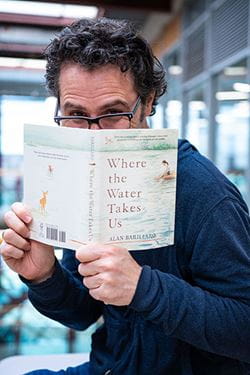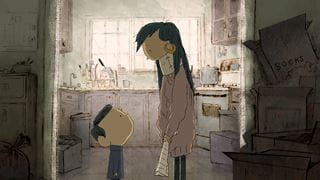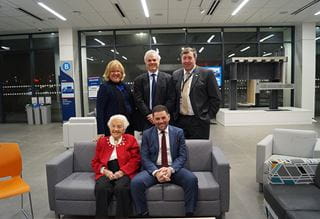
Oscar-winning animator Alan Barillaro pens a love-letter to Canada’s wild spaces in debut book
 by Vitusha Oberoi – Jun 21, 2023
by Vitusha Oberoi – Jun 21, 2023 “There are times when roads become rivers. Rivers with strong currents that pull you away and, whether you like it or not, take you away from home.” – Where the Water Takes Us
 In his debut book Where the Water Takes Us, animator Alan Barillaro (Animation ’96) has returned home – to Canada’s idyllic lakes and islands – to give us a story that chose him as its author long before he won an Oscar for the animated short Piper in 2017. Or even before his 25 years at Pixar, where he was celebrated for his contributions to some of the studio’s biggest hits, including The Incredibles, Incredibles 2, Wall-E, Monsters, Inc., Brave, and A Bug’s Life.
In his debut book Where the Water Takes Us, animator Alan Barillaro (Animation ’96) has returned home – to Canada’s idyllic lakes and islands – to give us a story that chose him as its author long before he won an Oscar for the animated short Piper in 2017. Or even before his 25 years at Pixar, where he was celebrated for his contributions to some of the studio’s biggest hits, including The Incredibles, Incredibles 2, Wall-E, Monsters, Inc., Brave, and A Bug’s Life.
It’s a story that for years defied his tools as an animator and when Barillaro could no longer deny it, he quit Pixar, taking up a book deal with Candlewick Press to become a first-time author and take the leap into the unknown.
“The truth of it is, I always wrote. I love to write, and there’s a vulnerability to it that's very frightening. When you work on a movie, you can hide behind a lot of people and say we all did this artwork together. But it's daunting to say, ‘OK, here's more of me, and this is the story.’ The Academy Award gave me the confidence to take a risk for my story. If I could hand out Academy Awards to everybody, I’d do it right now and say, ‘OK, now go take your risk and tell your story.’ ”
Leaving Pixar to chase his story
The very lessons he learned in his 25 years at Pixar – to choose meaning over style and focus on what one wants to communicate as an artist – are what eventually took him away from the studio.
“The Academy Award gave me the confidence to take a risk for my story. If I could hand out Academy Awards to everybody, I’d do it right now and say, ‘OK, now go take your risk and tell your story.’ ”
“To me, it was the most Pixar thing to do, to leave Pixar. Because that was what I had learned – to put the story first and tell the story that you want to see out in the world, the way you want to see it,” he says.
“I do love the idea that as an artist, I'm not stuck. It’s not that, ‘Hey, you're a watercolour painter, so you only can use watercolour.’ You can do a watercolour and also sculpt in clay. They say different things, and to me it’s exciting as an artist to communicate in different mediums and not feel I’m pigeonholed into one.”
Where the Water Takes Us, to be released on July 11, is primarily for middle-schoolers but it is a book that would be of equal interest to parents who’d like to understand the complexities of the emotions a child experiences while growing up. Barillaro, refusing to be confined to a single art form, has both written and illustrated the novel, with his sketches in the margins giving it the fluidity of a flipbook and also water that’s at the centre of the story. He says when he started writing the book, he purposely didn't draw because he was worried that would get in the way of what he was trying to say in words. “The first thing I drew was months and months after writing, and it started with sketching a wave because I wanted the book’s cover to create that sense of water pulling you in, a feeling I remember as a child.”
Having broken down the barriers that confined him to a single art form for over two decades, Barillaro is all set to take his book to the storyboard and turn it into a film. Passion Pictures, where he works as Creative Director, announced at the recently held Annecy International Film Festival that it was in development of Where the Water Takes Us and shared a first look at a still from the forthcoming teaser.
Bonds with nature at heart of creativity
Where the Water Takes Us is what Barillaro calls a ‘summer book’ that he wishes he himself could have read as a boy. It’s a foray into his creativity, shaped during a childhood in Ontario’s cottage country, where the bond between nature and humanity is as pervasive as the water that surrounds its many islands. Every page of the book is a celebration of the sights and sounds of Canada’s wild spaces – the songs of robins, shimmering dragonflies, pine canopies, beaches, boats, hidden coves and cottages. It’s a canvas painted with words where 11-year-old Ava, away from her family and haunted by fear, learns the meaning of growing up and crosses the threshold into adolescence.
Like his protagonist, Barillaro formed an intrinsic bond with nature when he too was 11 years old. His parents got a small cabin on Catchacoma Lake in the Kawartha Lakes region and from then on, he spent his summers canoeing, fishing, and exploring the islands that dot the lake, an experience that he says shaped the artist he would become, and the stories he would tell.
“I do love the idea that as an artist, I'm not stuck. It’s not that ‘Hey, you're a watercolour painter, so you only can use watercolour.’ You can do a watercolour and also sculpt in clay. They say different things, and to me it’s exciting as an artist to communicate in different mediums and not feel I’m pigeonholed into one.”
“When you think of a film or a novel, you want it to be a story you wish was out there. To me, that story was about Canada’s cottage country and its lakes. We look for answers in a lot of places, but truthfully, some of the life lessons are there in nature and that’s tied into all my work,” Barillaro says. If in Piper, a little sandpiper hatchling must overcome her fear of the waves for food and survival, young Ava of Where the Water Takes Us has to come to terms with the things she can’t change as she fears the worst for her pregnant mother who’s expecting twins.
A story of growing up, finding courage, and overcoming fear
In the book, Barillaro explores the anxieties of a child unable to share her fears, with a sensitivity that comes from his own experiences as a parent who had watched his daughter’s world change with the arrival of her twin brothers. “I do think it's important to recognize that a child has anxieties and I tried hard not to trivialize that or look down upon Ava. A story about a girl's anxiety and a certain loss of control we all feel at times, felt like a worthy and powerful topic for this book,” he says.
“We look for answers in a lot of places, but truthfully, some of the life lessons are there in nature and that’s tied into all my work. So there’s a little bit of intentional specificity for this to be a Canadian novel, that I’m proud to say made it on to every page.”
From Canada’s jewels of nature to the small kitchen in the woods where Ava tries to find solace while her nonna deftly rolls out pasta, Where the Water Takes Us is a coming together of Barillaro’s personal experiences and his creative imagination. This synthesis of the personal and fictional to anchor a story and yet make it soar on the wings of imagination is an art he says he learned from acclaimed animation artists he came to know during his time at Pixar, such as Japanese director Hayao Miyazaki.
“What you learn is that you can bring in parts of yours and the story will take it somewhere else. It'll be fictionalized. There are pieces of all that I know merged into the new lake I create in the book. I would want you to feel that you are in Haliburton and Muskoka, that you’d know this place is somewhere in the cottage country because that’s where you’d lose the phone connection due to the Canadian Shield. It might sound fantastical to others but to Canadians, it is like: ‘Yup. That’s the real thing!’ So there’s a little bit of intentional specificity for this to be a Canadian novel, that I’m proud to say made it on to every page,” he says.
Family important in creative journey
Barillaro’s personal experiences, including his family, have always played an important part in his creative journey, and he often looks to them for inspiration and help. If his reference footage for Piper came from the underwater GoPro images captured by his then nine-year-old daughter and seven-year-old twin boys during a family trip in Kauai, while writing Where the Water Takes Us he had his daughter read out the dialogues between Ava and Cody MacDonald, the boy she meets on the island, to get the right tone.
“It’s a long journey for everybody, whether it's a film or a movie, and they (family) have always been deeply involved. I really wanted the dialogue to feel right for the book and because sometimes, you think you are getting it all right when you write, and then you say it out loud and you want to crawl into a hole because it is so terrible. Cody represents a certain philosophy that pushes and pulls on Ava. I wanted to have a natural kind of cadence to their banter back and forth. So I had my daughter read it out loud with a friend, while I adjusted the dialogue until it had the right rhythm.”
To Barillaro, the power of literature is very important. “I like being a storyteller and having that emotional experience of connecting with an audience. You are rich if you have that experience in life. It’s a privilege to get that chance and to get it right in whatever medium expresses it best. You give it as much as you can, and you don’t shoot for anything but the stars.”
Photos: Academy Award winner Alan Barillaro (Animation '96) during a recent visit to Sheridan.
Media Contact
For media inquiries, contact Sheridan’s Communications and Public Relations team.



